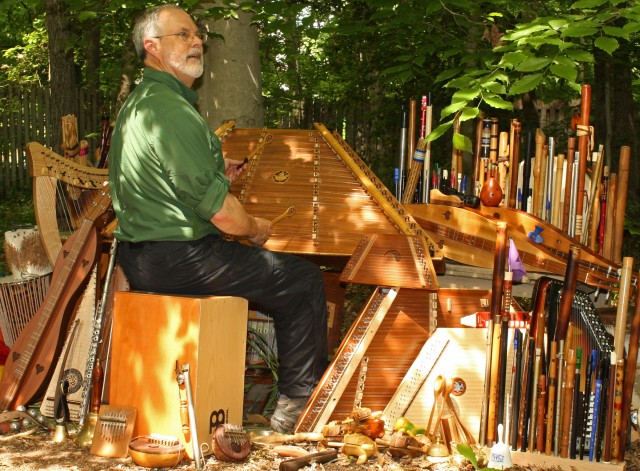“Excelsior” is a Latin word meaning “ever upward.” Aspiration is an important part of every aspect of our lives! We need a sense of hope for better things, more noble things, more joy and adventure and ultimate fulfillment. Certainly our music arranging can reflect this. I have compiled ideas here that I employ to give a sense of “excelsior” in my arranging and playing music, and I often experience a new elation as I perform, no matter what the form of the music is. Some of this concept is already built into the source melody or chords --- perhaps that’s why I choose to use them in the first place --- but I can consciously incorporate many other techniques as well to flesh out the progressive joy or drama. I do hope that you too can find your own elation through using some of these!
(A couple of references in the text are for players of hammered dulcimer --- but all of these thoughts can be used by any musicians.)
1) Modifying a melody with notes above:
- My biggest personal emphasis: Vary the melody by incorporating higher notes between the melody notes.
- Multiple notes repeated
- Dronelike
- Rhythmically (like the use of the fifth string in old-time banjo, perhaps)
- Along this line, a 'pedal tone' of a continuous playing of the fifth scale step (e.g., an A note in the key of D) above the melody can give the impression of yearning for eternity in the way Bach applied the idea --- powerful!
- Melody below the accompaniment part instead of above it (melody on the bass bridge, with zig-zag arpeggios after each melody note for chord and rhythm)
- “Fill” motifs incorporating higher notes --- when the melody is not as active (especially at ends of phrases)
- Long, high notes (like descant, perhaps) instead of melody per se --- as in string pads, etc., or glistening accents above the melody while another player has the melody
- The highest note of a melody: Where is it in this particular piece? How shall it be handled in relation to the rest of the melody?
2) The highest point in volume or tempo as a point of emotional focus; including swells and rubato in the course of a phrase as well --- a distinct way of making the music more colorful!
3) The meaning of development toward a climax: Keep in mind the “overall arch of the piece” throughout, with a conscious goal of developing toward a most-intense or most-excited or most-complex or most-focused moment or section near the end. This may actually be a “plateau” of slow, quiet, serene beauty that opens out from a “climb.” (I love the way this last is so effectively done by Alasdair Fraser in his Scottish fiddle arranging and George Szell in his realization of symphonies!)
4) The highest developmental point in a piece: Consider the place where there is the most action or the most complex chord texture, or even the most counterpoint of parts (melody/improvised answering part, or multiple melodies, or suspensions or overlapping chords, etc.).
5) The highest point in an improvisation: Plan to play an improvised part in such a way that it has a sense of development and a logic that leads toward an especially intriguing moment before ending.
6) Modulation (changing overall pitch location):
- Higher octave in same key
- From major key to minor key (e.g., G to Em or D to Dm)
- Higher key: Effective value of each different interval
- ---2nd and 4th: Intervals commonly used for a sense of “lift” (e.g., from C to D or D to G)
- ---3rd: Dramatic, startling shift (e.g., from F to A [major 3rd] or D to F [minor 3rd]
- ---5th: An effect quite similar to a 4th (e.g., from lower octave C to higher octave G)
7) The highest point in a longer set of pieces:
- Concert set: Plan it for its narrative flow, with tension and release, with engaging beginning and eventual rise to climactic point before the end.
- CD song list: Plan in the same way as for a concert set.
- Suite: You may want to have a series of pieces follow a theme, either in telling a story (e.g., a historical event or a trip) or in focusing on ideas (e.g., plants and animals of Virginia) or in musical connections (e.g., melody elements that share the same note combinations, maybe).
Any or all of these techniques can make your music --- and by extension, you --- come more alive!





Comments